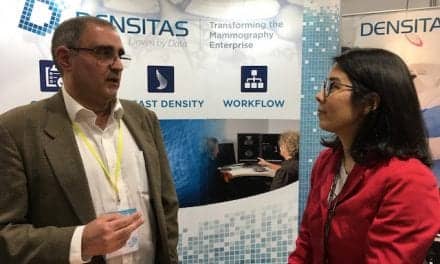By Amanda Renee Baker
 The Bella Blanket, a patient comfort offering by Beekley Medical, is a protective coverlet for mammography designed to cover both the top and front of the receptor plate of the mammography unit. The company states that the coverlet provides “added protection for the breast and inframammary fold,” and increases patient comfort by “remov[ing] the chill from the bucky/receptor plate.” The Bella Blanket is designed for both digital and analog units and is available in two sizes (18×24 cm and 24×30 cm). In addition to improving patient comfort, Beekley claims that use of the Bella Blanket can help technologists increase tissue acquisition, which ultimately leads to improved visualization for radiologists.
The Bella Blanket, a patient comfort offering by Beekley Medical, is a protective coverlet for mammography designed to cover both the top and front of the receptor plate of the mammography unit. The company states that the coverlet provides “added protection for the breast and inframammary fold,” and increases patient comfort by “remov[ing] the chill from the bucky/receptor plate.” The Bella Blanket is designed for both digital and analog units and is available in two sizes (18×24 cm and 24×30 cm). In addition to improving patient comfort, Beekley claims that use of the Bella Blanket can help technologists increase tissue acquisition, which ultimately leads to improved visualization for radiologists.
Alice Quinn, director of Imaging at Hunterdon Medical Center in Flemington, NJ, said that her team started using Bella Blankets 1 year ago, hoping to find a solution for the skin irritation and skin tears under the breast that some patients experience during a mammography exam. Quinn said that after beginning to use the coverlets, she saw a “dramatic difference” in the patient experience: patients found the cloth surface soothing, and discovered that it was effective in reducing skin tears and easing discomfort often caused by the cold receptor plate.
Quinn believes that the comfort provided by the Bella Blanket makes a mammogram easier to perform, and yields more accurate results. Patients are more likely to remain still while the mammography is being performed if they are at ease, she explained, and less motion leads to a sharper image. She found that the accurate fit of the Bella Blanket on the receptor plate and the friction caused by its cloth surface effectively prevent the breast from sliding on the receptor plate, allowing the technologist to capture a clearer image. In addition to improved clarity, Quinn stated that the fit and texture of the coverlet allow more breast tissue to be captured in a given image.
 Beekley Medical states in their ad for the product that the use of Bella Blankets yields increased tissue acquisition in 77% of patients compared to prior year images. June Arton, a radiological technologist, and her team at Laborde Diagnostics in Lafayette, La, have been using Bella Blankets for 1 year. They had sampled Bella Blankets and initially had opted to continue using a competitive product based on patient response that indicated a preference for the thickly cushioned surface offered by the competing brand.
Beekley Medical states in their ad for the product that the use of Bella Blankets yields increased tissue acquisition in 77% of patients compared to prior year images. June Arton, a radiological technologist, and her team at Laborde Diagnostics in Lafayette, La, have been using Bella Blankets for 1 year. They had sampled Bella Blankets and initially had opted to continue using a competitive product based on patient response that indicated a preference for the thickly cushioned surface offered by the competing brand.
However, when Arton heard about the studies stating that the use of Bella Blankets resulted in increased tissue acquisition, they decided to run their own tests to compare the two brands. Arton said she was “impressed” by how much more tissue was captured using the Bella Blankets and indicated that the padding of the competing product, while offering an increase in patient comfort, was degrading the image and negatively affecting tissue acquisition. Her facility ultimately decided to switch to Bella Blankets. “To me, getting more tissue is what’s important,” she said.
Though neither Arton nor Quinn felt that Bella Blankets have had a significant impact on patient throughput, Quinn suggested that the increased comfort the product offers helps to build a stronger rapport between patient and radiologist, and that building that relationship in a trusted environment is an important component in encouraging women to return for their screening mammograms on a regular yearly basis.
“There are patients who, if they are not offered a Bella Blanket, will ask for it,” Quinn said, and noted that the facility’s Press Ganey Surveys have reflected a significant increase in patient satisfaction based on their experiences with Bella Blankets. This, in turn, positively impacts reimbursement. Most important, the increase in patient satisfaction due to the use of the Bella Blankets potentially leads to clearer and more accurate images, and a more comprehensive examination overall. “In the long run, tissue acquisition is directly related to patient cooperation,” said Quinn.





